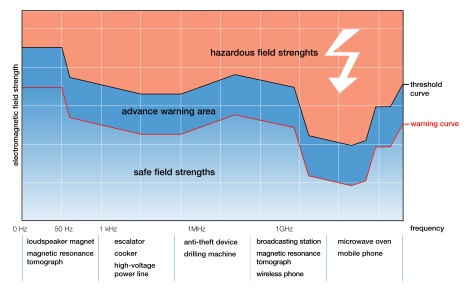Examples of potential danger sources of electromagnetic radiation are:
- anti-theft devices
- broadcasting transmitters
- loudspeaker magnets
- wireless or mobile phones / cell phones
- electric tools and machines
More examples are plotted in the chart on the right or can be found in the references of pacemaker suppliers. In almost any case the actual risk depends on the distance between the disturbing source and your pacemaker or defi. This phenomenon can easily and directly be watched with the Cardioman.
Cardioman helps …
- to determine the minimum distance to dangerous appliances
- to prove the information given in appliances' instruction manuals
- discover damaged devices with bad risk
- but also to identify devices that bear no risk
More safety by early warnings
Thresholds for the exposure of pacemakers depend on the frequency of the disturbing field. In all ranges the Cardioman already alerts before the threshold is reached. This is illustrated by the advance warning area in the chart above. After that a number of appliances that can have interfering effects on pacemakers are listed.
Reasons for failure or interference
The public debate about electromagnetic pollution concerns whether or not the human body can be affected by electromagnetic radiation. The scientific position is still not clear. Anyhow, there are guidelines and directives that include limits for the electromagnetic compatibility of electric appliances.
In case of pacemaker or defi patients we have a different problem: Here, the body is not directly interacting with the electromagnetic radiation but indirectly via the implanted electronic device that is in addition equipped with an electrode acting as an antenna. In this case we have to consider not only biological but also and primarily physical effects.
In spite of increasing safety with respect to external radiation there still remain failure hazards even with modern pacemakers. You can find more details in Background.
In most situations no interference of the pacemaker will occur. However, in rare cases malfunctions can lead to light or severe heart rhythm disturbances. The patient recognizes this as dizziness, inefficiency, or even unconsciousness. And defi patients can experience unwanted shocks. If the patient is dependent on a permanent stimulation, the worst case is cardiac arrest.

 Deutsche Version
Deutsche Version